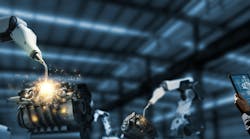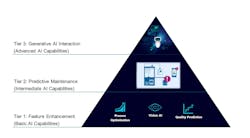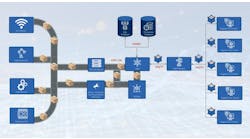Transforming machine building with artificial intelligence
With the rise of artificial intelligence (AI), machine builders face historic opportunities for growth, as well as historic challenges. For many machine builders, it can be difficult to grasp the full potential of AI-enabled enhancements. You may have learned about exciting new capabilities like vision AI for quality control, but that’s only the tip of the iceberg.
While these capabilities offer tremendous value on their own, it’s time to think bigger. For example, imagine if you could talk directly to a machine in plain English and receive detailed repair instructions. Picture an onboard chat AI. With this type of generative AI, the machine could tell you in simple language why it’s not operating correctly or what isn’t working and offer step-by-step instructions to fix the problem.
Get your subscription to Control Design’s daily newsletter.
For forward-thinking and enterprising machine builders, AI presents a once-in-a-lifetime opportunity to carve out new market share and lead the way with a new automation paradigm. However, there’s no shortage of pitfalls along the way. Identifying a sound AI strategy and executing on that plan is much easier said than done.
And, with so much hype and buzz around AI, it can be easy to lose sight of the bigger picture: what challenges does AI actually solve for machine builders? How can it help you deliver more robust, feature-rich and value-added machines for your customers?
And how can you deploy AI in a manner that is proven, sustainable, scalable and easy to maintain?
Some manufacturers have unlocked exceptional value with AI. Machine builders must deliver real value with AI-enabled enhancements, from development and deployment all the way to optimization.
Read Steffen Klawitter's article: AI for machine builders: Can it live up to the hype?
Recognizing the full value of AI: 3 tiers of AI-enabled enhancements
Some of the biggest misconceptions around AI come from an underestimation or underappreciation of the transformative power of this technology. Machine builders often have trouble recognizing the full value of AI for customers. To better understand the value offered by AI, it can be helpful to think of AI-enabled enhancements in terms of tiers (Figure 1).
Tier 1: How an engineering organization can automate quality inspection with AI anomaly detection
The first tier, which is also the most straightforward to implement, is adding new features to your machines. From AI that enables robot arms to more reliably and efficiently pick up irregular objects to defect identification, there’s no shortage of valuable features that you can add to your machines with AI.
A company in the fields of engineering and technology can provide a great example of how AI can be used to improve quality inspection with electric components. Let’s say, for example, this company was looking for a more reliable and efficient method of checking for defects in metal springs, which form the electronic connection between the main circuit board and a copper bushing on the cover of a sensor.
In order to improve quality inspection, this organization created a process where a 5-megapixel camera captured an image from above for each component. These images were analyzed with AI anomaly detection technology, which used two neural networks—a local and a global network—to identify defects. The local network checked for small-scale defects like scratches, cracks or dirt, whereas the global network used a broader perspective to check for bent or missing brackets. From the interference of the two networks, the global context anomaly detection tool determined an anomaly score.
This manufacturer then used this anomaly score to identify which parts should be further manually inspected. The benefits of this technology are multifold. For training, the model does not require any time-intensive labeling of images; it only needs to be provided with good images. Furthemore, the model did not require any extraction of all possible defect types. As a result, the process offered a considerable savings of both time and money compared to previous rule-based machine vision methods.
Tier 2: How a machine builder can use AI-powered predictive maintenance to avoid downtime
The second tier is making your equipment more robust with predictive maintenance and anomaly prediction. With AI, you can predict machine breakdowns before they occur and create new levels of efficiency in maintenance schedules.
AI possesses an impressive ability to analyze vast datasets and uncover patterns that are either imperceptible to humans or too costly and time-consuming to identify manually. By gathering data on factors like machine movement, machine temperature and ambient conditions like the temperature and humidity on the shop floor, AI can anticipate the need for specific maintenance procedures with uncanny accuracy.
As an example, let’s say an automation manufacturer leveraged AI-powered predictive maintenance to great effect with machine suction grippers.
This organization identified a need for a different maintenance approach as worn-out suction grippers were wasting energy, as well as creating machine defects and availability losses. They wanted to be able to better predict service intervals across unevenly wearing machines and needed a scalable infrastructure to integrate with existing software.
To address this need, the manufacturer evaluated programmable-logic-controller (PLC) data from the machines with anomaly detection on an industrial edge device. By using edge infrastructure, they eliminated the need for time-intensive connectivity programming or security hardening and scaled globally.
The result would be a reduction in unplanned downtime for machine customers, along with reduced energy consumption, optimized service planning and remote service offerings. Machine users could also visualize the data worldwide via web-accessible dashboards displaying various key performance indicators (KPIs).
Tier 3: How to optimize production by asking a question
As exciting as predictive maintenance is, the third and final tier of AI implementation is a radical transformation of how manufacturers interact with their machines. With on-premise generative AI, you can not only talk to a machine to diagnose and fix machine problems, but even discuss optimization opportunities and production statistics.
Imagine optimizing your production by simply asking a question. For example, you can ask the machine to describe any issues or discuss its current performance, and it may tell you exactly how much faster or slower its cycle time is today versus yesterday and why.
If you want to dig further, you can ask the machine how this station’s performance can be improved. In doing so, you’ll get a list of action items such as optimizing calibration, what equipment could be upgraded or maintained, and even which personnel could benefit from additional training. It even lists supporting observations, so you can understand the rationale behind these suggestions.
Road map for AI use in machine building
The opportunities and possibilities for AI in machine building are staggering. However, effectively and sustainably introducing AI to customers is a complex and difficult process. So, what does it look like to take AI from ideation and assessment all the way to a successful production rollout, operation and continuous improvement (Figure 2)? And what separates a successful AI implementation from a costly failure?
It all starts with looking at the challenges AI can solve and asking whether AI is applicable. Start with a digital assessment to explore the goals and challenges of the customer, current infrastructure and what challenges could be best solved with AI.
The next step is digging deeper with a feasibility study. This is a rigorous study of whether the implementation of AI is realistic, how it compares to similar successful applications of AI and what technologies must be considered. Furthermore, the feasibility study will look at whether the organization can support this initiative from a cultural and process perspective and whether the right IT/OT systems are in place. Lastly, a feasibility study will calculate an expected ROI.
If the results of the feasibility study are promising, the next step is to design an AI product and provide proof of value. This means either creating a prototype or reviewing an existing prototype, testing the concept and ensuring it will be scalable across operations. At every step, carefully consider whether it truly supports the business’s unique goals and desired results.
Once you have a validated prototype and have established scalability and proof of value, it’s time for a production rollout. This includes installing scalable OT/IT infrastructure and implementation with connectivity, hardware installation, validation and testing.
The last step is operation—operating and monitoring the AI-enabled automation in a live operational environment. This includes continuous improvement, as well. Every AI model will need to be periodically retrained over time and reviewed to ensure it is still delivering the correct performance.
This journey may sound intimidating, but as a machine builder, you don’t have to do it alone.
Unlock the value of AI together
Just as planning is the most important step in implementing AI, having the right AI partner to assist you through this process is crucial. With the right partner, you can dramatically bolster your ability to provide significant value to customers in a sustainable, scalable manner.
When evaluating a partner for your industrial AI journey, consider the depth of experience and expertise they offer. Many companies can design an AI product for automation. But finding a partner that can create a product that is proven, sustainable, scalable and easy to maintain is much more difficult.
For example, every AI will need to be retrained and adapted in response to inevitable changes on the shop floor. Something as simple as a change in lighting in a customer’s factory could require the AI to be retrained. AI-enabled automation should be able to recognize any unusual conditions and retrain itself accordingly. This dramatically reduces the burden of ongoing maintenance and training required for any AI model.
Despite the challenges, the potential for growth and innovation in the machine-building industry has never been more profound. In the rapidly evolving landscape of AI-enabled automation, the possibilities for machine builders are limitless. The bright future of machine building with AI starts today.







